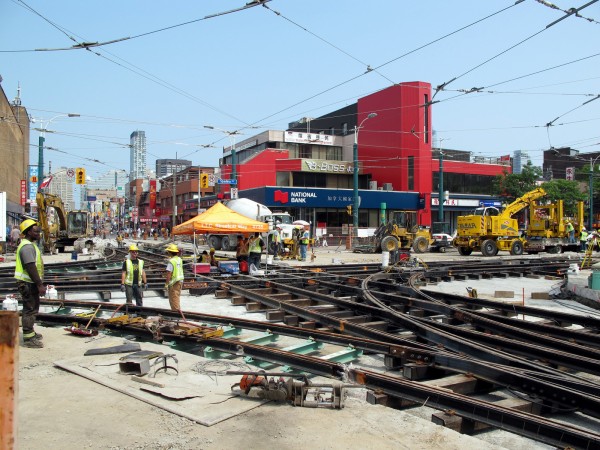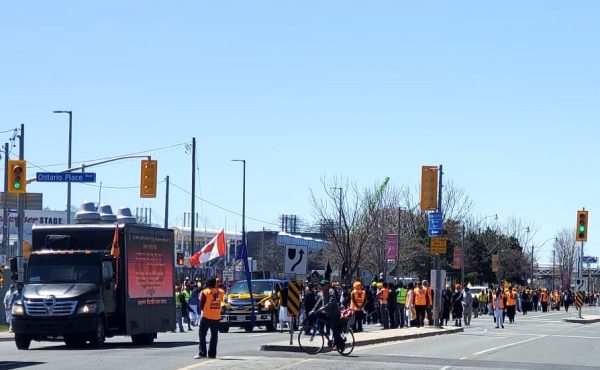If you’re ever in the market for a choice example of bureaucratic obfuscation, look no further than the following section in the slightly amended version of city council’s newly unified transit vision, which was approved last week, and will be returning to the executive committee in June in a somewhat more detailed guise.
Appropriate sequencing of the range of projects will be the subject of further analysis. The resulting outputs will need to be further consulted upon with the TTC, Metrolinx and the public. This includes determining where there is alignment between the City’s priorities and Metrolinx’s regional planning and prioritization [italics added by me].
Three passively constructed, cryptic sentences which, when read together, point ever so delicately towards the gaping chasm that lies between all the beautiful maps and an action plan that actually begins to deliver a more coherent vision of rapid transit in Toronto.
Most observers believe the looming psycho-political hump has to do with financing and revenue tools. Indeed, there’s no doubt in my mind that the near unanimity we saw in council last week will erode noticeably when the members get down to the hot potato work of figuring out how to pay for all these projects.
But the element in all this visioning that is consistently AWOL — or at least is kept hidden from public scrutiny in a basement vault marked “radioactive” — is any frank discussion of prioritization.
The map comes with many new lines, and about ten of them, City staff readily concede, are more important than the others. The City and/or Metrolinx can’t build all of them at the same time, nor, indeed, should they. Some are critically important, in terms of the health and viability of the network, while there are others that, if built first, could serve to exacerbate the crowding pressures we all know exist.
In short: must haves and nice-to-haves. Let’s build them in order, in the way that the TTC and the City now prioritize capital projects (e.g., state of good repair, regulatory or statutory improvements, service expansion).
Maybe I’m asking for the impossible, but I have not yet seen a staff document that clearly states the order of importance of the proposed lines and provides a clear rationale based on an evaluation of what happens as different routes come on line.
Alternatively, I haven’t seen a document that compares scenarios — here’s what happens if we do things in order A, compared to order B or order C. Rather, we’re expected to play along with the fiction that the high priority lines will all be built in the next 15 years, and that Toronto, circa 2031, will have some variation of the Network 2011 transit plan that Metro Council approved in 1985, almost half a century earlier.
I understand the three bureaucratic sentences above were written by worldly mandarins who know perfectly well where their work ends and where the politicking begins. I also realize that the very difficult discussion about how to fund all these projects is intimately connected to the question of prioritization. The men and women at City Hall need to think about elections and providing their constituents with hope that the world, or at least their corner of it, is improving.
Yet it seems to me that City and TTC staff, at some point, need to provide both the public and their own political masters with a rigorous technical analysis that openly tackles the question of prioritization, or at least provides some options and a means for council to judge. It’s a report that should identify the points in the system that show the greatest degree of vulnerability, as well as opportunity, and then offer three or four explicitly phased build-out strategies that, if implemented in order, would systematically move the city towards a more sustainable network.
By dancing around this problem, the City’s bureaucrats are leaving the field open to the kind of horse-trading that allowed us to spend almost a generation tied up with subway extensions leading to nowhere instead of building lines that relieve pressure on the over-taxed sections of the network with measures that go beyond productivity enhancements (signal replacement, re-jigged trains, etc.).
The City has extensive forecasting and modeling capabilities, so council should know what happens if we build the east and west extensions on the Crosstown LRT, for example, before the Relief Line. Or what happens if the City does Smart Track before the Scarborough extension. And so on. These phased scenarios, of course, are dynamic, because it’s possible that one project will render another one less urgent or (perish the thought!) unnecessary. It’s also possible that funding will dry up mid-roll out, so surely it makes sense to start with the projects that provide the most high impact solution the soonest.
The phasing also has a bearing on future financial discussions. After all, if we prioritize lines that will get relatively little ridership early on (which can last for decades, as the Spadina subway has shown), the increased burden on the TTC’s operating budget will factor into subsequent debates about how much the City can borrow or levy for later projects. Again, a highly dynamic scenario.
I have not a shred of doubt that the senior planners tasked with stick-handling this epic undertaking through city council are acutely aware of the phasing and prioritization issues. But rather than hide from this most critical part of the debate, I want to see the City’s planners and technical experts present council and the public with competing scenarios and the network/ridership implications for each one.
Everyone knows that at some point, city council will have to choose an order. The onus is on the City’s top officials to impose some order on the debate about order.






9 comments
The project that is in my neighourhood should be first.
Seriously, the projects that benefit the most people and riders should be first. Looks like the DRL to me, and I do not live it the area of the DRL. I live in the west end.
Let the planners decide what to build in what order. Councillors should be limited to setting the objectives and budget then approving it. The size of the budget will determine what is being built at the time and how fast it moves along, planners have to work within that constraint.
When councillors try and do both – what and how much then there is too much politicking going on as per the Gardiner east. If they had set an objective first with a budget i.e. we have $500 million then the only option on the table would have been boulevard. If the budget was set at $1 billion they could have come up with boulevard + $500 million for other transportation enhancements which would have allowed an apples to apples comparison of the plans.
Councillors your choice is a hybrid elevated freeway in that one spot or a boulevard with bicycle highway down the Don River valley which will reduce demand for a freeway.
The current transit priority is finishing the proposed upgrades to the Barrie line (Davenport Overpass) and Stouffville line (grade separation of Scarborough Junction and double tracking north of Agincourt). Combined with the changes to UP Express fares this creates a three corridor “Relief Network” that gives people an option for long distance transit.
Extending the current GO-Metropass pilot to include all stations in the $4.71 and $5.02 zones (rather than just Exhibition and Danforth) would make GO service far more accessible to more passengers in Toronto. For example, $4.71 from Union gets you to Exhibition & Bloor GO. $4.98 gets you from Union to Mimico and Long Branch. $5.02 gets you from Union to Weston, York U, Scarborough, Kennedy, and Eglinton GO stations.
The question is, if people have the option of purchasing, say, a $50-55 sticker for unlimited monthly travel in 1 zone, and a $65-70 sticker for unlimited monthly travel in 2 zones (on top of a Metropass) would they do so? If so, then some of the pressure on the subway system can be transferred to the GO network, provided there are enough services to meet those levels of demand.
That would, hopefully, give us the time needed to implement important local transit improvements, namely building the Relief Line (and moving forward on the north and west extensions as soon as possible), bus corridor improvements (which are easier and faster to implement) and the Crosstown extensions (which should be designed to open in sections as soon as construction is finished).
Chris Williams… Really? Your expectation when you vote for a City Councillor is they’ll prioritize the needs of people at the far distant edge of the city first?
“Setting the objectives” is about picking the priorities, and it’s what the politicians have to do.
Downtown Relief Line first, although we should probably rename it Pape-Queen or Pape-Richmond Line at this point.
Disclaimer: Building the DRL has no effect on my regular commute, nor would it benefit me financially.
I expect the prioritization will be based on “what can be paid for”. Which, frustratingly, probably leaves the relief line to an undetermined future.
Considering how we are already going to completely overhaul the SRT and refurbish the rolling stock. I find it a bit stupid we will be tearing it down to build a subway. With the money committed to the subway we could extend the SRT and replace the rolling stock with the same cars that. The sky train uses since it’s the same technology just a generation newer cars. But this is to practical and I guess Scarborough is to good for anything less then a subway.
Gotta love how the city’s biggest transit project (Eglinton Crosstown) will only serve to exacerbate the TTC’s biggest transit problems (Yonge line overcrowding and Bloor interchange overcrowding).
I don’t have a ton of faith that automatic train control will really improve the situation that much.
I also don’t believe that the much needed mini-DRL that *may* get built in 15 years at the earliest will correct the situation.
Under the current leadership, City and TTC staff are now being so political, that they have forgotten that their job is to be technical and factual. Telling people what is true vs what they want to hear is now considered to be “arrogance,” so we have finally got the type of planning-by-committee that we have apparently always wanted. The kind that promises everyone everything that they want, and delivers very little of real value.